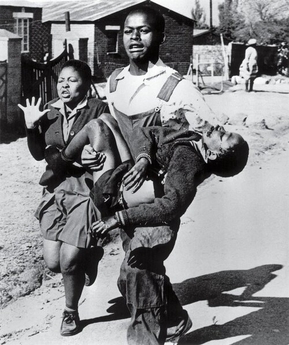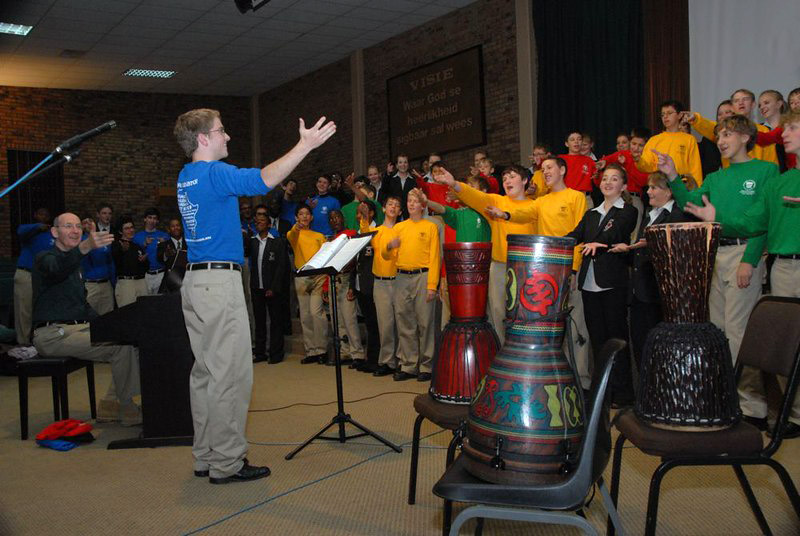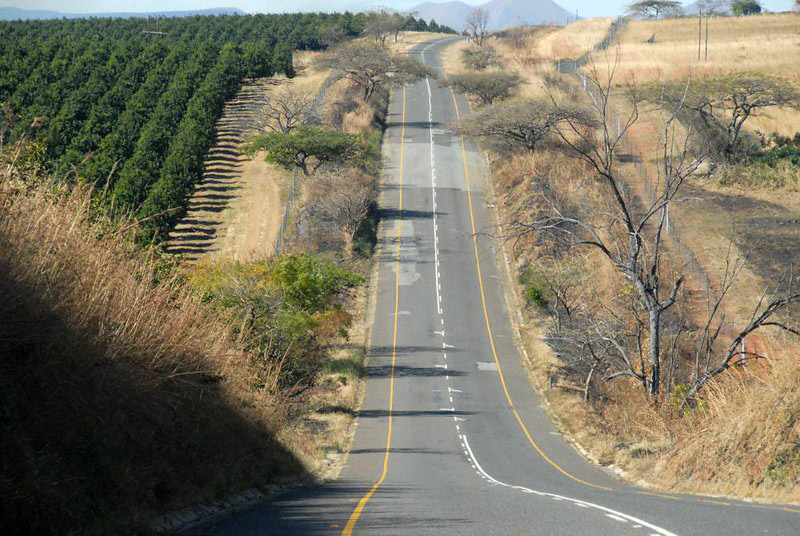Keystone State Boychoir
South Africa – A Very Short History
| return to the South Africa 2011 Tour page |
South Africa lies on the Tropic of Capricorn in the Southern Hemisphere. It’s a parliamentary democracy. The government is divided into the same three branches as ours, but each branch is located in a different city, each of which the boys will see. The “administrative” branch (our executive branch) is in Pretoria, the legislative branch is in Capetown, and the judicial branch is in Bloemfontein. Each of these cities is in a different one of South Africa’s nine provinces. The boys will be visiting Gauteng Province (Pretoria, Johannesburg, and Soweto), Northern Cape Province (Kimberley), KwaZulu Natal (Drakensberg), Mpumalanga (Kruger), and Western Cape (Capetown).
| The southern part of the continent of South Africa quite possibly contains the earliest evidence of human society. Caves in the region surrounding Johannesburg (Jo’burg!) show evidence dating back 3 million years! While early groups of humans were either hunter/gatherers or herders, a highly organized civilization existed some 800-900 years ago: Mapungubwe. Artifacts discovered there come from as far away as China, showing a complex trading system existed. |  |
European influences in South Africa began humbly; with the creation of a vegetable garden! The Dutch East India Company wanted vegetables grown for the benefit of the sailors travelling the eastern trade routes to India. (Boys! Eat your veggies!) Jan van Riebeeck landed at the Cape of Good Hope in 1652 with 90 men. Within ten years there were at least 250 white settlers and they were beginning to argue with the local Khoisan population.
|
Over the next hundred years, the South African colonies changed hands from the Dutch to the British and back again several times, as immigrants entered the land coming from the Netherlands, Germany, and France as well as Great Britain. The local Xhosa fought against the settlers claiming land.
A “Great Trek” of 12,000 Afrikaners (Boers) began to move north and east, away from the now British-controlled (and slave-banning) local government and toward the possibility of new and better lands. These “Voortrekkers” pushed their way into what they may have thought was vacant land, but ended up fighting against the Zulu and their kings Shaka and his successor Dingane. Piet Retief thought he had negotiated a land exchange with Dingane, but Dingane and his warriors slaughtered the settlers and their leader. The Voortrekkers took a stand at the Nacome River against an overwhelming Zulu force and won the “Battle of Blood River” in December of 1838. |
| By 1871, the discovery of several large diamonds set off a “New Rush” with thousands of men digging what became the Kimberley diamond mine. Conflicts between the Boer and British populations intensified leading to the “First Boer War” in 1880-1881 and the “Second Boer War” from 1899-1902. |
In 1931, the “Union of South Africa” was granted independence from British direct rule. At this point, several laws had already stratified the divisions between blacks, whites, and “coloureds” including the “1913 Land Act” which reserved 90% of the land for whites. In 1961, whites voted to leave the Commonwealth under Queen Elizabeth II and became an independent republic.
In an act of unified protest, the ANC – African National Congress – was formed in 1912. Despite delegations sent to Britain to protest unfair treatment of blacks (and other non-whites); strikes; and protests peaceful and not; in 1948 a Nationalist government actually affirmed and codified apartheid restrictions such as the types of jobs non-whites were permitted to hold, where they were allowed to live, and rules about buying and carrying weekly passes.
Over the next several decades, the official government policy of apartheid dug in with more and more restrictive rules. Organizers like Nelson Mandela joined in the 1952 “Defiance Campaign” and formed the multi-racial Congress Alliance. In 1962, Mandela was sentenced to three years in prison. He was pulled out to stand another trial with ANC colleagues and sentenced to life on Robben Island. In the meantime, the UN had started enforcing economic sanctions against South Africa.
 |
On the 16th of June, 1976 (while the US was gearing up for the summer bicentennial celebration) the school-children of Soweto organized to march in protest. The government had recently decided that half of their education should be conducted in English and the other in Afrikaans – which most of them and their teachers as well did not speak. In addition, schools for white children were funded at more than ten times the per-pupil expenditure than black children, and black children had to pay tuition, books, and supplies! The children gathered as they marched, with up to 15,000 participating. Government officials responded with live ammunition. A twelve year-old boy, Hector Pieterson, was the first to be killed. Conflicting reports number the dead from 20 to 200 from the next several days.
Over the succeeding years, the government both gave and took away. Blacks were allowed to become legal residents of cities and their teachers were trained. But police were allowed to stop them without cause. In 1989, Prime Minister P W Botha began talking to Mandela in jail. His successor, DeKlerk , continued in 1990. Nelson Mandela was released on February 11, 1990. |
The current government of South Africa was negotiated between 1991 and 1993 with new elections held in 1994. On May 10th, Mandela was sworn in as president with DeKlerk as one of his deputies.
A couple of interesting observations about the South African National anthem. First it starts in one key and transitions to another (okay music geeks?) and is sung in a total of five different languages (of the eleven official languages of South Africa).
Main resources for this page:
South Africa’s History and Heritage
A brief history of the African National Congress
Digital Innovation South Africa
SA Politics
South African History Online
Wendy Adventures – A VCU professor on Fulbright studies this year.
South African Trivia and Phrases
An education professor from the University of the Free State is presenting at ISTE in Philadelphia, 6/28/11. She says:
Students often walk 20km each way to school. High school students often need to go home to feed younger siblings and, due to household complications, they may not be able to return for the remainder of the day. Sometimes there are no parents due to the AIDS epidemic so that these older children are responsible for the rest of their siblings. Classes often have 60 students. Teachers frequently teach subjects outside of their own educational expertise. Technology is so rare that everything is used, including cell phones!

Selma
On the 50th Anniversary of Selma, KSB remembers all those who who have fallen along the way to making MLK’s dream a reality. May they inspire all of us to get up, every day – in our own way – and keep walking until his dream is fully realized. On that day, all people – everywhere – will be judged only by the content of their character.
Our last day…
We began our last day of tour by sleeping in. Nice! We arranged to have breakfast extended with a brunch menu of fresh Norwegian fish soup. Yum! Actually, it wasn’t until Mrs. O renamed it “seafood bisque” that the boys went for the fish soup.
We then headed to the park for another run around. It was just too beautiful not to enjoy it again. And there was one last bucket item left to check off – swimming in freezing Norwegian waters. Quite a few boys made the plunge. You had to go in over your head for it to count. Exhilarating! And really, really, really cold.
Then it was off to town. At the Polar Museum we enjoyed an Imax-like film on the Northern Lights (which unfortunately you can only see in winter) and Svalbard (been there done that), and then watched seals do tricks for food. Not unlike boys on tour. If you jump through the hoop boys, we’ll feed you.
From there we broke off into chap groups for last minute shopping and dinner. Some ate at the northern most Burger King in the world. Some ate at cafes. One group I heard got treated to a very nice dinner by their chaperone. Wait until that chaperone sees the credit card statement!
As for the infamous Grad Night, it came in two parts. The first involved the graduated and rising seniors and the second involved all those boys in high school. I can’t offer many more details than that, since what happens on Grad Night stays on Grad Night. But they were memorable outings.
The best part of our last day involved all the boys and all the staff and chaps. Yet another new tradition: “The Paper Plate Awards.” Any awards ceremony worth its salt has a performance or two. Ours began with the final scene from Ibsen’s masterpiece A Doll’s House. Our “Abington mob,” on their own initiative, decided to make their own history by staging the northernmost reading of the play. At any given moment during our time in Svalbard, you’d see them at it. You have to love these guys.
The challenge for the Paper Plate Awards was there was no one scene that included all the boys involved. So we did a bit of comedy sports. The final scene was selected, involving only the two main characters. The other actors could chose their favorite line of their character and interject it anywhere in the final scene. Hilarious. The curtain call went on for many minutes. The audience broken into the traditional Norwegian clap that signifies “more, more!” It was a rousing success.
Then, to the Awards. Every boy got at least one one. Some of the awards were silly. “Best PJs.” “Most intense card playing” Some were serous. “Best Tour Journal” “Most Improved Performance Focus” Those came with cash prizes. The big prize of the evening was the “KSB Tour Award” for the boy who personifies everything KSB stands for. His prize was the coveted polar bear drawing given to us on the Svalbard boat trip. Post-Award ceremony, we gave a second KSB Tour Award to a boy who has been a quiet but ever-present, steady, reliable, and most importantly, kind member of KSB. Going forward, this will be called the Ubuntu Award. Ubuntu, if you recall, is the South African word that means “a person is a person through other people.” It is a philosophy South Africans live by. It is not a coincidence that choral music is so important to South Africans. It is the perfect manifestation of ubuntu. Connectedness. Whole greater than the sum of the parts. Community. That’s what KSB strives to be. That’s the gift. More than the music, but only attainable through the power of music-making.
Of course, ubuntu went out the window when it came time for each big brother – little brother chap group to compete for the best performance of the Norwegian birthday song. The inventiveness of some was impressive. Others were impressive in how bad they were. The great part was seeing trebles and Grads working and singing together. And so in that way, ubuntu was at play. Each group, after their performance, received their official Norway pin, signifying the successful completion of tour. The pin will live on their Jacket, for all to see that they were part of the KSB 2012 Concert Tour to Norway and the Arctic Circle.
We finished the evening with important thank yous. To our chaperones who gave of their time and resources to care for the boys. It’s often a thankless job, but an essential one, without which we could not tour. (BTW: they all won the “Best Chaperone Award.”) To Martha, our fearless choir manager and author of our fantastic tour journal. To Mary Ann Case, our beloved membership coordinator and everyone’s choir mom – especially on tour. Fitz said lots of nice things about me and I said lots of nice things about him, and almost most of them are true. J
We closed out the tour with a final thought for the boys. Stephen Sondheim wrote a lyric I live by: “if life were only moments, you’d never know you had one.” Being a member of KSB takes commitment and dedication. We try to have fun all the time when making music, as Leonard Bernstein advocated, even when rehearsing music. But the reality is, sometimes its just plain hard work to meet the high choral standard of the Keystone State Boychoir. And that’s okay. It’s not supposed to be easy. Endeavors that are easy are usually fun, but are rarely special. What the Boychoir does is very special indeed. The “moments” are our reward, but they’re special because of the hard work, the sweat, and sometimes even tears, required. They’re also special because they don’t come every day. And many young people never experience such moments of achievement at such an early age. This taste of success will foster a desire for more successes, more achievement, more moments.
Our promise to the boys is, as long as they are willing to make the commitment to KSB, we the staff are committed to offering them unique life-changing musical, social, and cultural opportunities he cannot find anywhere else.
So job well done to the boys on representing their families, their choir, their city, state and country so well. Thank you to the parents who, with their leap of faith and trust, made all of these wonderful moments for their sons possible. I look forward to many more moments with them.
Peace.
We arrived in Piet Retief by bus from Drakensberg an hour later than expected. This made for mad dash to our hostel, where we had to change and be at the venue ready to sing in an hour’s time. Thanks to our terrific staff and army of chaps, it was clock work. The boys actually got off the bus, found their rooms, got dressed, and got back on the bus in silence. Scary. As I’ve said many times, this sort of challenge is what I love about live performance and especially concert tours. Like in life itself, nothing goes smoothly, if something goes wrong, it will, and you have to be ready to roll with the punches, get down to business, and make it happen.
Our audience in Piet Retief was just lovely. This is a very conservative part of the country – a kind of Afrikaaner bible belt. They love Jesus first and foremost, but music is a close second. Apparently, the last time they had a visiting choir from oversees was 2003! The community was over the moon at our presence in their little town.

View the Photo Gallery on Flickr: Piet Retief
The format for the evening was unique. The concert opened with prayers by a local minister. He followed his scripture quotes with a “blond” joke. (He’s allowed one a night.) We then heard from the Highveld Youth Choir, who sang beautifully. At intermission we were given a bowl of beef and rice (lekker!), and then we came back and did a second half of our music. Boy did they eat us up. They gave the Grads a standing ovation after the very first piece they sang – which the Grads just loved as you can imagine. We also got a standing ovation after “Baba Yetu.” It was a love fest.
After the concert we went to the local Wimpy, the big fast food chain here. The wait and kitchen staff were stunned at the thought of serving 86 people an hour before closing. But they did it, and we treated them to a medley of old and new South African songs. Another tour moment. To see the entire Wimpy staff singing and dancing with us, beaming from start to finish, was an uber tour moment. The formal concerts have all been great, but these impromptu concerts are magical. You’d have to see it to believe it.
We’re now on our way to Kruger National Park. The boys are psyched. The vistas we’re seeing are other-worldly. It’s always an effort to keep the boys in the moment. Tour, and life, is a journey, not a destination. They’re so excited at the thought of seeing “the big five” in the wild that they could easily miss the live National Geographic show outside the bus windows if we let them.
Don’t worry, we’re not letting them.

View the Photo Gallery on Flickr: July 15 – from Piet Retief to Safari!
July 15th started with a “goodbye sing” to the folks at Piet Retief who hosted us and who rose extremely early to feed us. The ride through the South African countryside never fails to enchant all of us as we move from round-topped hills to flat-lands and from dried grasses to green pine forests to banana trees. The scorched roadsides (and the fires we saw everywhere) were finally explained to us. Farmed and grazed fields go right up to the edges of the 2-lane highways. If there were to be a vehicle accident which caused a fire, then entire farms and livestock would go up in smoke. The owner of the farm where the fire started would be responsible for the damage caused by the spreading fire. So, the farmers create a fire-break by burning a swath along every road or driveway. (There are no mowers). This both decreases the risk of fire, but also increases visibility along these roads.
